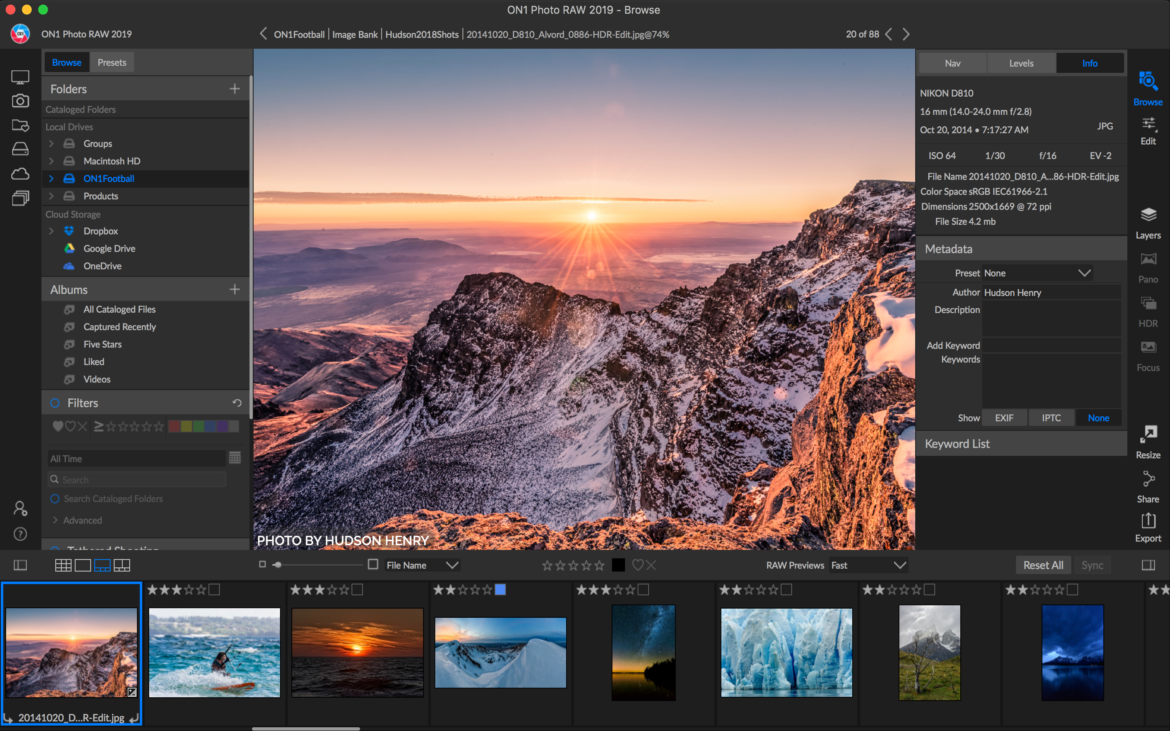Digital picture use is rising rapidly. Currently, in 2020, mankind will take 1.4 trillion pictures.
Where are all these images going, and how are they being managed?
For artists and organizations of all types, handling, arranging, and maintaining digital content in the cloud is a major concern.
Plus, the requirement for additional room comes with better picture efficiency. And the need to rapidly and conveniently navigate these picture collections comes with a higher number of images.
This is where tools for picture management comes into action.
Tools for photo management assist citizens and companies:
- Save pictures and organise them.
- Quickly localize image data.
- Integrate your digital archive with apps like PhotoShop and InDesign for photo editing.
- Upload the images, rotate them, and export them.
- Locate raw files and sync them with tools for graphic design.
- It can also store video files and combine them with software for video editing.
- And, in this article we’ll discuss a lot more.
This article ranks and analyses the best picture management applications focused on ease of usage, storage and organizing features, integration, pricing, help, and more to make your decision easier.
Let’s get to this page.
What’s the Right App for Picture Management?
For picture management apps, below are the top options.
1. Adobe Bridge.
Best app for total picture management ($20.99 a month).
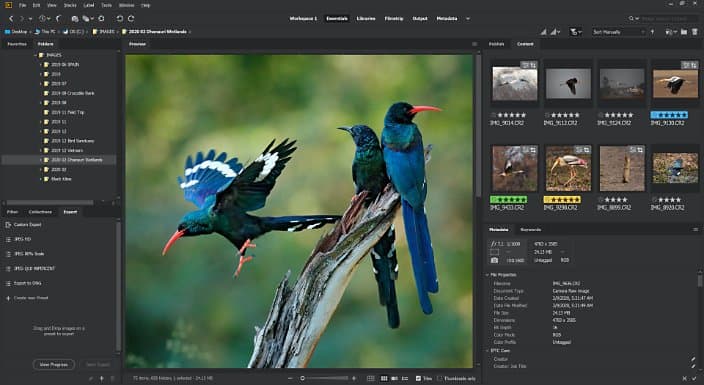
Adobe Bridge: application for handling digital properties
Adobe Bridge is an app for digital asset management that helps you to easily preview, upload, organise, and post several images. To arrange your images, it also helps you to update metadata and add marks, keywords, or scores.
Search and filter options for metadata also assist you to identify and manage the holdings in order. The picture management software also deals with different collections, which enables you to directly publish your images to Adobe Stock.
Additionally, with rich previews and bold thumbnails, you can imagine your photos. You can also modify your images directly from inside the Adobe Creative Cloud applications by opening them.
Three main features have recently been introduced to Adobe Bridge:
- Export the files to formats such as DNG, TIFF, and PNG in bulk.
- Centered on the short side, resize pictures.
- Disable the clarity of thumbnails on and off.
New Features of Adobe Bridge
Main Functionalities:
- Adobe Portfolio-Build your pictures, InDesign, or drawings with a skilled portfolio via PDF contact sheets.
- Adobe Camera Raw- For editing, access the raw photos straight from the Bridge.
- Upload all your digital photos using Photo Downloader to convert them during the upload or rename them to DNG files. Photo Downloader
Pros:
- With several scale and size choices, it is capable of batch exporting or renaming your images.
- Stacking and arranging panoramic or HDR pictures easily.
- Using your macOS to download videos and images from a digital camera or cell phone.
- Build a website for Adobe directly from Bridge.
- Metadata on-demand and thumbnail creation.
- Create galleries of your images, drawings, or InDesign files using PDF contact sheets.
Costing:
Adobe Bridge is not a separate tool; the full Innovative Cloud kit costs $20.99 per month and ships with it.
2. Magix Photo Manager.
Good for beginners who are searching for free applications for picture management (free).
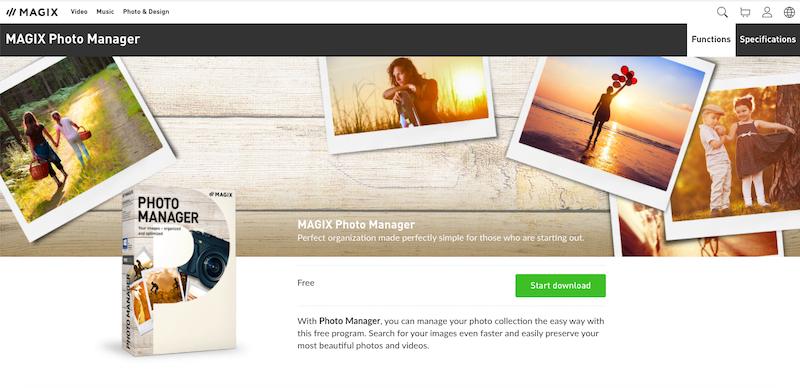
Image Master Magix
Magix Picture Manager is a free software that lets you upload, sort, and arrange your images and videos for picture organization. The optimized user interface enables you to instantly edit, create slideshows that can be conveniently posted, and import photos straight from the camera.
To search videos and images from your gallery, you can also use its adjustable display modes and personalized folders. Plus, for better management, you can score and categorize pictures.
Picture Manager for Magix: Categorize & score images
It provides a dark-colored backdrop to highlight the pictures correctly. Finally, post your images and videos directly to many social networking platforms including YouTube from Magix ‘s dashboard.
All in all, from a single dashboard, Magix lets you control, present, and post your pictures and videos.
Main Functionalities:
- Cloud Import-Import images directly from various providers for cloud storage. This will help you combine the photos already saved in the cloud with your local camera collections.
- Wireless Import- You can use WiFi straight from your mobile to upload your videos and images.
- Facial Recognition-The Magix picture manager will quickly recognise faces and help you locate pictures of a single user. Using its free version, you can save up to 10 faces.
Pros:
- In only a few taps, you can customize tone, sharpness, contrast, and picture brightness.
- Backup your media to a DVD, Usb, and hard drive quickly.
- Directly burn the slideshows into a DVD or CD.
- Describe photos that include memories, places, and titles.
- Music, commentary, and sound may also be applied to the slideshows.
- It offers 600 MB of free disk space for downloading programs.
Costing:
A freemium tool is offered by Magix Picture Manager that lets you control and categorize your picture set. However, with more sophisticated picture processing and editing tasks, it has paying plans.
Here are all the Magix price plans offered:
- Image Manager for MAGIX: Free
- MAGIX Deluxe Picture Manager: $49.99
- MAGIX Deluxe Picture Story: $69.999
3. ACDSee.
Best ($59.99, one-time payment) for robust RAW assistance.

ACDSee-tool for automated asset management
ACDSee is a platform for digital asset management that lets you organise images with features like facial recognition and data position. It also lets you browse, filter, and distribute the selection of your media. You will make the workflow smoother with features like personalized groups, import-free access to the images, and keywords.
In addition, performance-based modification layers and parametric photo editing functionality are also supported by ACDSee. To edit your photos exactly the way you like, leverage RAW editing and digital asset management toolsets. GPU-enriched tech also says that the modified files are viewed at a quicker clip.
Main Functionalities:
- Location Data-The Map panel reveals the geotags that mark the location where the photos were taken. It isolates groups of photos utilizing embedded longitudinal and latitudinal data depending on the area they were clicked on. It also helps you to drag and drop photos for geotagging on top of that.
- Facial Recognition-It recognizes faces so that you can quickly name people and scan for videos.
- RAW Support- For more than 550 digital camera versions, it provides RAW support.
Pros:
- They give free newsletters, guides, lessons on photography, and seminars that are helpful for beginners.
- You will import Picasa and Lightroom pictures.
- Connect with ACDSee on your cell phone and share photographs and videos straight from your smartphone.
- Process and store batch images.
- Look for Drag and Fall.
- Crew Customer Service is open from Monday through Friday.
- For the entire product, you gain admission to a 30-day free trial.
Costing:
ACDSee pricing begins with a one-time charge, per consumer, at $59.99. There’s no free edition, but the complete version can be tried for free for a month.
4. Google Photos.
(Free) Best for newcomers and small companies.

Google Photos: Best Tools for Photo Management
Google Images is a free photo storage app that enables you to backup your videos and photographs from every computer and view them.
You may either move and drop your images directly to Google Photos from your system or press the “upload” icon.
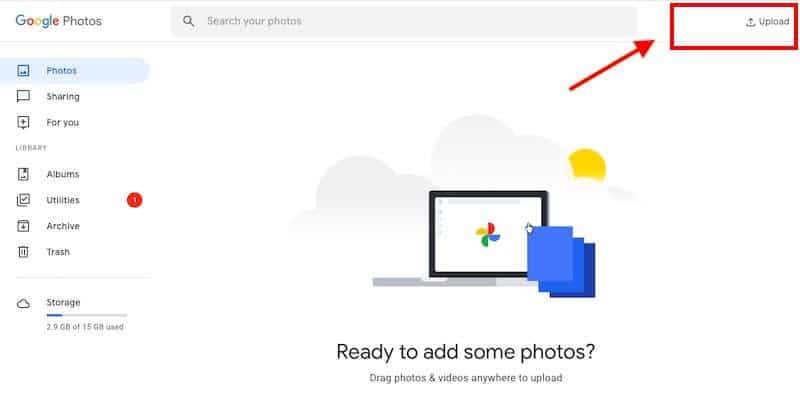
Choice to Upload Google Images
Google Images organizes all the photos instantly and makes them searchable until they are saved to cloud storage. To locate the image you are searching for, you only have to type specific keywords in the search bar. It also helps you to scan for photographs dependent on multiple variables, such as incidents, persons, and places.
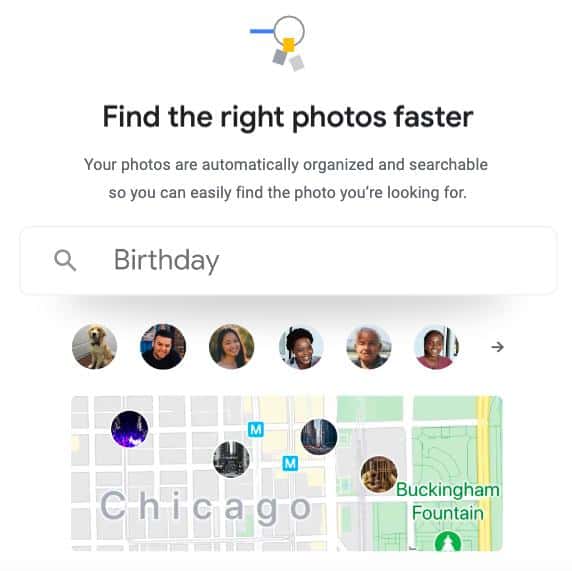
Characteristics in Google Images
You can also post your pictures or albums with friends and family easily. To post it on any social networking site, you only have to pick the networking you want to share or build a connection.
In order to help you edit and store your files, Google Photos also provides editing software and different filters.
In addition, it lets you sync all of your gadgets, including cell phones , laptops, and computers, with your data.
Main Functionalities:
- Picture Prints- In an album, picture journals, and canvas prints, you can have your pictures and libraries printed. It also provides a pickup on the same day at your nearest CVS or Walmart. The prices start from $0.25 for picture prints.
- Suggested Sharing-The ‘Suggested Sharing’ feature of Google Images displays photo groups at the top and depicts activities together with face bubbles.
- Albums Page-The AI engine automatically displays pages along with the albums you make with the picture.
Pros:
- The exposure, colour and brightness of the photographs may be changed.
- Metadata is produced and images are stored in bulk.
- The AI-based assistant utilizes identical pictures to create animations and slide-shows.
- Geo-location and picture details is automatically collected from digital cameras and smartphones.
- You may use object-based search to identify files that you don’t know the names of.
- Depending on your storage availability, you will upload photos at different resolutions.
Costing:
Google Images has infinite storage and is completely secure. However, only 16MP quality images can be stored, although videos are compressed to 1080p.
You should apply for the paid subscription plan that begins at $1.99 a month for 100 GB if you wish to preserve original data. The good news is that up to 15 GB of this package is also eligible.
5. Adobe Lightroom.
Best ($9.99 a month) for cloud computing.
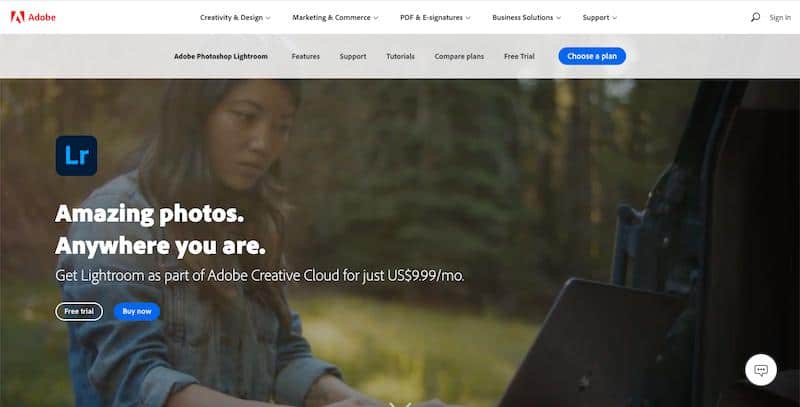
Adobe Lightroom-cloud-based management of images
Adobe Lightroom is a cloud-based app for picture management that helps you to edit, organise, store and upload your photographs on any computer.
It comes with AI-technology to handle multiple photos at once instantly and store all the edits done on your smartphone. In addition , it offers a function for machine learning that recognizes individuals and themes and produces albums on its own.
Initially, for most graphic designers and mid-sized firms, you get 1 terabyte of cloud storage for free, which is enough. However, whenever needed, you can purchase more room.
It often uses non-destructive modifications to remove the need for several versions of a picture to be stored. This ensures that editing modifications will be saved thus maintaining the initial files and the same image updates.
Main Functionalities:
- Photo Labels-Use organizing resources, including scores and flags, image tags, and a simple click to construct albums instantly.
- Adobe Sensei-The faces, positions, things, themes and colors in the photographs are automatically identified by its machine learning. This role allows you to locate the images you are searching for, whether or not you have included the appropriate keywords.
- Photoshop on the iPad Integration-Send your pictures directly to Adobe Photoshop on your iPad from the Lightroom library and vice versa.
Pros:
- For simplified searchability, auto-tagging of images.
- Easily connect your laptop, smartphone, or site images.
- Directly import photos from texts and email attachments.
- Using scores, flags, and albums to arrange photos.
- An automated backup of your photos is required.
- Lightroom also lets you handle either smart device or machine from the image collection.
- It allows access to all the files from every computer that you wish to share.
- To support you get started, Lightroom comes with step-by – step directions and tutorials.
Costing:
For $9.99 a month, you may buy Adobe Lightroom as part of Adobe Creative Cloud. You get a 7-day free trial as well.
6. digiKam.
Best tools for free and open-source picture management (Free).

DigiKam: open-source and free-of-charge
DigiKam is a picture management program that is free and open source that can accommodate collections comprising over 100,000 photos.
It allows RAW files or images to be imported, handled, modified, and exchanged. Photos, images, and RAW data may also be downloaded directly from external storage devices or digital cameras.
The images posted are grouped into albums that can be sorted by:
- Chronologically, mentally,
- By arrangement of directories
- Or by personalized sets,
To filter and locate your photos, you can even add keywords, notes, and metadata-and do away with folder restrictions. In addition, it lets you group images by file-name , date, and time-lapse together.
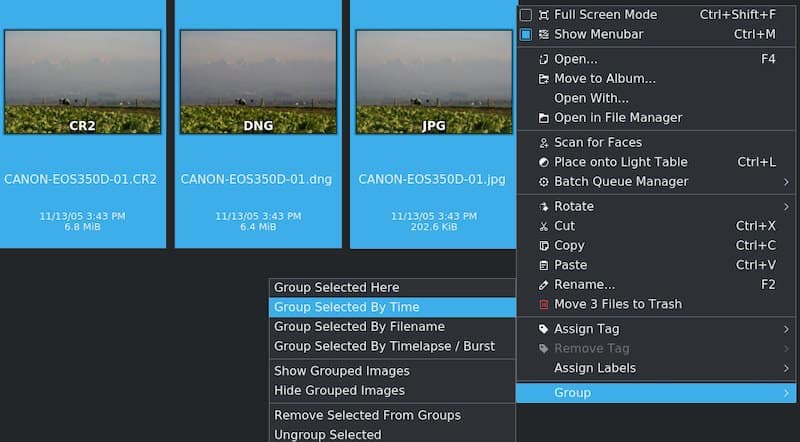
Features of DigiKam: Group images
Import rules and configurations that coordinate and process the photos may also be configured. The light table feature of digiKam also enables you to check your photos and touch particular places.
In addition , it offers labeling software that allow you allocate images and RAW files with names, marks, and scores. To easily locate the stored images, you can then leverage filters.
Main Functionalities:
- Search Capability-You may use factors such as marks, tags, rank, location, details, and basic IPTC, EXIF, or XMP metadata to search the picture library.
- LibRaw-It will decrypt RAW data. Plus, to ensure it supports the new camera models, the catalog is kept continuously and frequently updated.
- Lens Correction-This leverages Lensfun-based program to allow image correction of automatic lenses.
Pros:
- It lets you handle video cataloging data.
- Works for Windows, Debian, and MacOS.
- To export and import images to third-party web services, you can write plugins, introduce new editing tools, and batch process files.
- You may store data on a server that is either remote or local.
- Using the ‘Tags Manager’ function to organise the properties and hierarchies of tags.
- To find duplicate pictures, use the function ‘Similarity’.
Costing:
DigiKam is an open-source application, and is also fully free to use.
7. FastStone.
Best ($19.95 one-time payment) with varied picture management and editing choices.
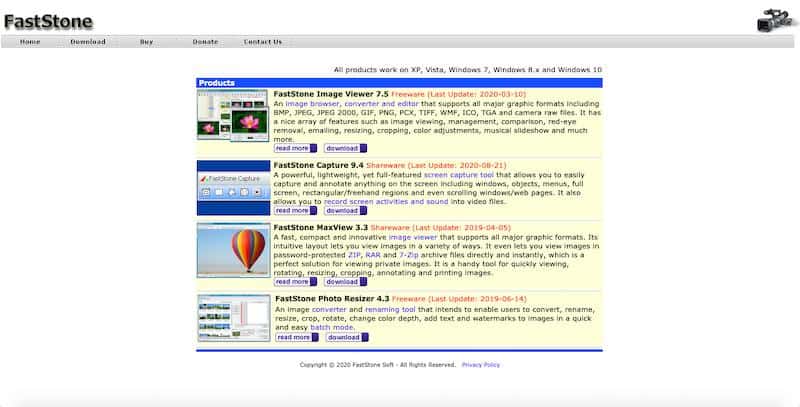
Photo management platform for FastStone
Faststone is a program for displaying and manipulating photos that enables you to arrange, modify, rename, and apply text and watermarks to your photos.
All major picture formats are provided by the site, including JPEG , PNG, BMP, JPEG 2000, animated GIF, ICO, TIFF, PCX, WMF, TGA, etc. Digital camera RAW formats such as CR2, CR3, NEF, CRW, PEF, DNG, RW2, X3F, and more are also supported.
For separate activities, FastStone offers four sub-products:
- An picture browser, translator, and editor — FastStone Picture Viewer. Apps such as picture display, management, red-eye reduction, resizing, cropping, color changes, etc. are offered. It also produces automated slideshows with support for over 150 purchases. And you can also add music to slideshows that allow MP3, WMA, and WAV formats.
- A screen capture application that helps you to capture and annotate everything on the screen. FastStone Screen Capture
- FastStone MaxView-An picture client that enables all major formats to view and handle pictures. You will also quickly access Archive, 7-Zip, and RAR files that are password locked. Additionally, you can rotate, annotate, scale, and print photos with FastStone MaxView.
- It lets you transform, rename, crop, and rotate your photos. FastStone Picture Resizer. Plus, in batch mode, you can add text and watermarks and adjust the color depth. Plus, it comes equipped with a platform for screen capture and video capturing that can monitor all screen operations, audio from microphones, mouse motion, etc. Additionally, it can grab formats like BMP, JPEG, TGA, Fax, TIFF, etc.
Based on your specifications, you can buy any of these instruments separately.
Main Functionalities:
Multithreading Supported-All sub-tools allow you to process several images using all your processor cores simultaneously.
Dual Display Support-FastStone helps dual-screen users with optimisation. You may even drag and drop some of the displays with the photos or the main browser.
Manage photos, transfer, shift, re-arrange files with drag, and drop support. Drag and drop function.
Pros:
- Set photos as desktop backdrop wallpapers for Windows
- To the pictures, apply text, arrows, forms, and several other items
- Assign snapshots and screen grab hot keys to
- Supports screens of high DPI and high-resolution
- The drag and drop function is given by the FastStone picture resizer.
- In your pictures, you can blur selected regions.
Costing:
Below are the prices of four separate picture management products from FastStone (all lifetime licenses are available):
- FastStone Picture Viewer: 34.95 dollars
- Capture FastStone: $19.95
- FastStone MaxView: $19.95 U.S. dollars
- FastStone Photo Resizer: 19,95 dollars
The Photo Resizer app, Faststone Picture Viewer, is free to use for personal and educational use, although FastStone Capture and MaxView need a license. However, if you are using them for some sort of commercial reason, you need funding for both instruments.
For 30 days, you can try FastStone Catch and MaxView for free.
8. Phototheca.
Best PC picture organizing applications (one-time charge of $39.95).
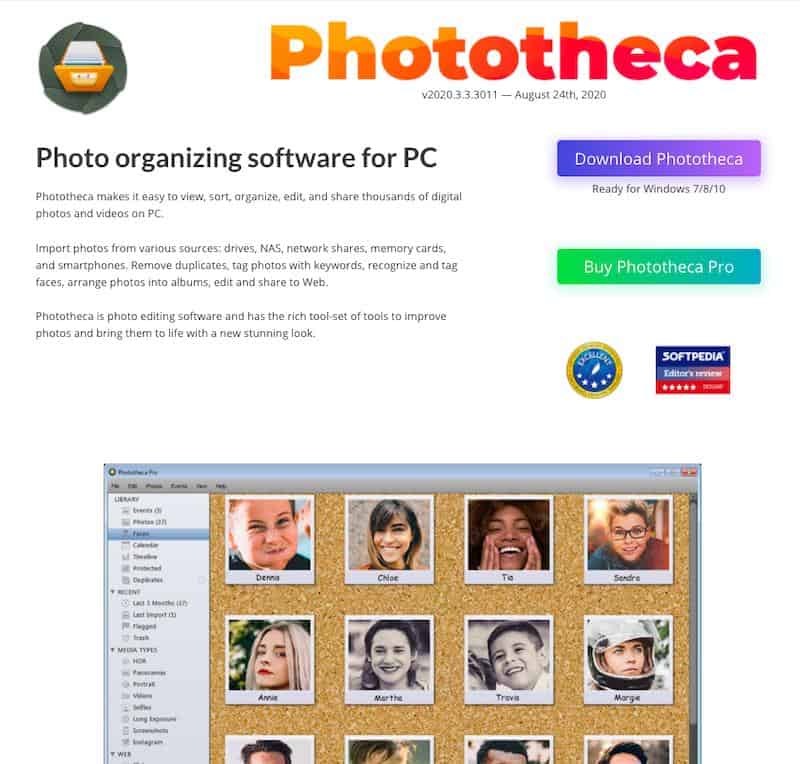
Phototheca: program for picture organizing
Phototheca is a program for organizing photos that allows your machine to store, display, arrange, edit, and upload pictures and videos.
You may source photos from many outlets, such as drives, NAS, network shares, memory cards, and smartphones, to begin with. Then, build a picture gallery, albums, folders, activities, and smart folders with various layers.
Finally, use keywords and locations to group images with dates, activities, schedules, nested directories, etc., and name them. The tagging purpose allows it easy for photos to be identified in the future. Plus, the dual view option encourages you to use the second window and arrange more room for images.
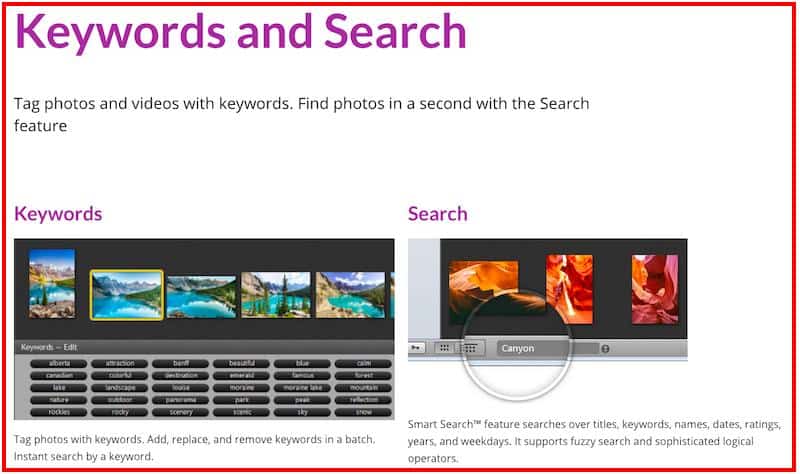
Phototheca: Keyword Characteristics
Not just this, but with only a mouse, you can even move photos from your PC to your iPhone. It also helps Flickr, Google Pictures, and Twitter to upload photographs directly.
Phototheca also scans the storage and deletes all the redundant photos automatically while maintaining the original image safe.
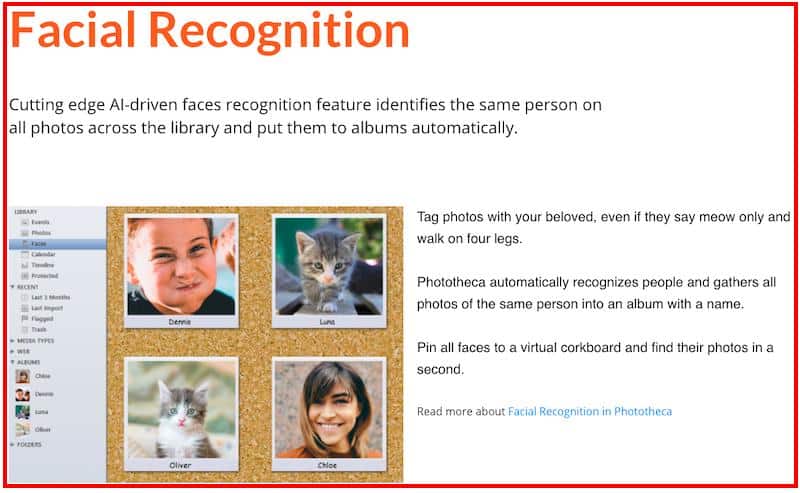
Additionally, a built-in picture editor comes with the PC-based picture management tool. It offers picture processing features such as noise removal, sharpening, de-hazing, coloring, white balance, and more.
Main Functionalities:
- Smart Albums-This function lets you compile all the images that follow the requirements you have defined.
- Capabilities for viewing: Phototheca helps you to zoom in and zoom out the pictures or turn to a full-screen mode. You may also run a slideshow to seamlessly display all the pictures.
- Facial Recognition-You only have to tag your pictures and the same person in your picture archive will be identified by its AI technology and grouped into a folder.
- Apps of Phototheca: facial recognition
Pros:
- Multiple RAW camera types are allowed.
- The Premium package for Phototheca operates for up to 5 PCs and will handle unlimited images.
- 56 high-quality picture filters are built-in.
- Native support for media forms for iPhones.
- Submit images directly utilizing Phototheca via emails.
- Hide picked images from albums that are password-protected.
- Duplicate function for photo identification.
Costing:
Three paid plans (for a one-time payment) are offered by Phototheca:
- Home: $39.95, up to 100,000 images are handled.
- Pro: $49.95, treats images of up to 250,000.
- Premium: $54.95, unlimited photo management.
For both of the plans, you will get a 30 day money-back guarantee. Plus, students get 50 percent off, and a 20 percent discount can be obtained from all educational institutions.
9. PicaJet.
Best ($59.95 for a single license) for multi-user usage.
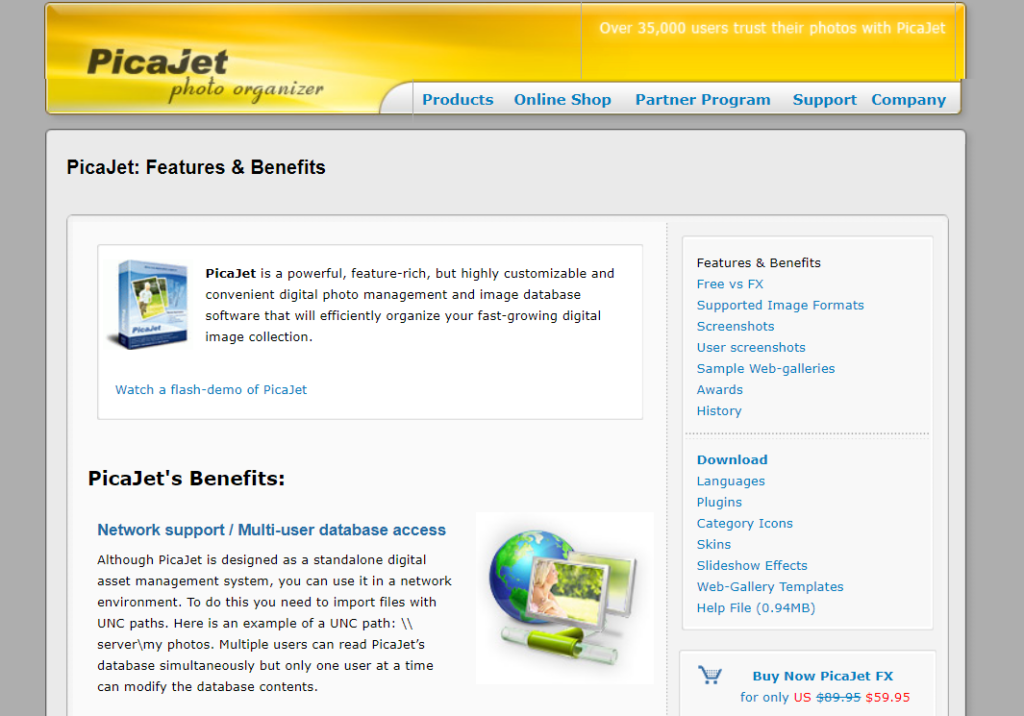
PicaJet-software picture archive
PicaJet is a program for picture management and image database that enables your digital archive to be arranged, filtered and sorted. You may arrange images into infinite layers of nesting groups, either complicated structures of groups or basic ones.
Using their database, several users will view images at the same time. Only one user, however, can modify the content of the database at a time.
To categorize pictures, you may use multiple symbols, making it easy to identify unique photos from a full set. It also helps you to store photographs in your local storage while holding smaller thumbnails on the hard drive of your PC. This function saves room for your PCs and enables you to view photos by clicking on the small-sized thumbnails directly.
Function PicaJet Icons
Over 60 document files and document types are provided by PicaJet, including JPEG, PNG , GIF, TIFF, BMP etc. Not only this, but all camera RAW file formats from Sony, Nikon, Canon, etc. are still supported.
Plus, all major formats, such as MPEG2, MPEG4, AVI, and more, can be imported, managed, and played.
Another useful function is the option to mask private photos. By just pressing Shift+Ctrl+H, you can cover photos and encourage anyone you choose to do so.
In addition , it provides an in-built picture editor with features such as:
- Transforming
- Croping
- Sharpening With
- Removal of Red-eye
- Sepia sepia
Main Functionalities:
- Quick File Indexing-PicaJet utilizes OpenGL graphic acceleration and image manipulation techniques by importing metadata information to index the file array. OpenGL also allows you to zoom images in and out smoothly with just a single click.
- Backups and Recover- The images and videos need to be immediately backed up. And if your hard disk crashes or gets corrupted, just press to recover all the photos or recordings.
- Slideshow software-The in-built slideshow software lets you build slideshows close to Hollywood style effects with different transition effects.
Pros:
- Exporting XML format data.
- The Adobe DNG format is supported by PicaJet.
- In a way that requires the least room on screen, PicaJet arranges images, protecting your screen before printing.
- PicaJet ‘s interface can be customized.
- Around the globe, it serves over 20 languages.
- In bulk, transfer images to JPEG format.
- Upload photos for free on Fotki and Flickr.
- Using whatever parameters you like, sort and community pictures.
Costing:
PicaJet provides two forms of (single-payment) licenses:
- Single License: 59.95 dollars
- Family License: $99.95 (on up to five machines installed)
10. Movavi Photo Manager.
Good for companies trying to sort multi-format images ($39.95).
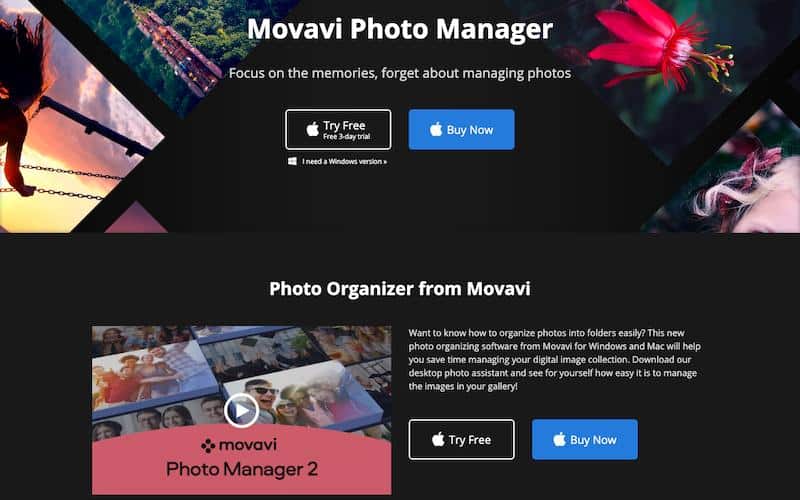
Photo manager for Movavi
Movavi Photo Manager helps you manage and edit the entire collection of your photos. All major image formats, such as JPEG , PNG, RAW, and more, are supported by the program.
Their software detects similar faces and compiles them into an album automatically. Then you can modify certain photos at the same time, or remove and batch organise them. The feature of facial recognition also detects images from the entire collection and creates separate albums for each individual.

Photo Manager for Movavi: Similar Photos
Besides, to find specific images and navigate the gallery, you can also add tags to your photos. Your photos, albums, tags and locations are also backed up by the Movavi photo manager. In the event of any loss, this function helps you restore your data.
The picture editor helps you to simultaneously edit single or numerous images. Plus, you have all the important features of picture editing such as cropping, spinning, sharpening, turning, straightening horizons, etc.https:/07aa883139d19f99316591e7a79ce8bc.safeframe.googlesyndication.com / safeframe/1-0-37 / html / container.html.
Main Functionalities:
- Geolocation-Movavi File Manager automatically sorts photo albums depending on the locations where they have been picked. Albums may be filtered through towns, too.
- Duplicate Photos-It searches the hard drive of your PC and extracts all the same images.
- Automatic Folder Creation-All the photos are sorted and galleries are created based on date and GPS coordinates by the picture manager.
Pros:
- Simultaneously edit several files.
- Add images with tags, messages, and graphics.
- To recreate old images.
- Adjust the backdrop of the picture or delete it.
- You have a free trial for 3 days.
Costing:
Three pricing plans are offered by Movavi Picture Manager for both personal and company use:
Personal: Personal:
- Image Manager: 39.95 dollars
- $59.95 Photo Manager + Photo Editor:
- Image Editor + Image Planner + Slideshow Maker: $79.95
Enterprise:
- Photo Manager: 99.95 dollars
- Image Manager + Photo Editor: 149.95 dollars
- $199.95 Photo Manager + Photo Editor + Slideshow Maker:
- A 3-day free trial is included with all the plans.
11. Zoner Photo Studio.
($4.99 a month).
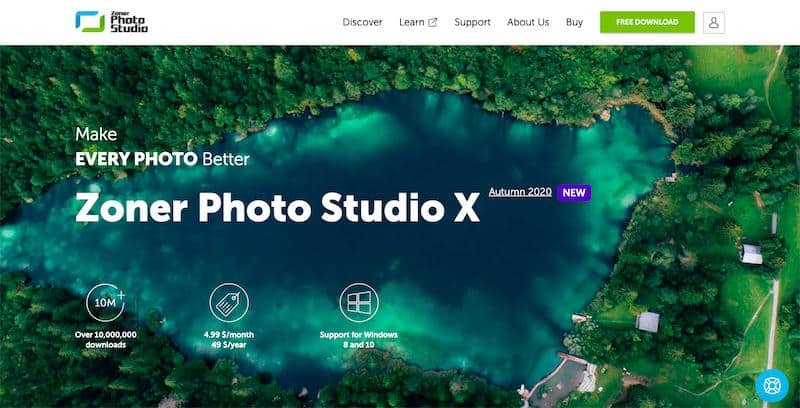
Image Studio Zoner
Zoner is a program for picture arranging that has four sections: Manager, Build, Editor, and Construct. RAW encoding, layer support, presets, and cataloging are some of the basic functionality.
You can quickly copy photos to the machine from your camera and the app can organize them into various files. You can tag or rename your images, add keywords & details, and create fast backups at once.
Browse the media library after marking and grouping them through times, keywords, places, files, and more.
Other than that, with its picture editor, Zoner Photo Studio lets you develop your images. You can apply colors to the images, apply a mystical aura, radial filters, etc. through the picture editor.
In addition, the photos can be posted directly from Zoner to social media such as Facebook, Twitter, Messenger, etc.
Main Functionalities:
- Damaged Disks-You can also view pictures from damaged and infected hard drives.
- Zoner Picture Cloud- In cloud storage, this function holds all your images secure. The simple plans include up to 20 GB of room for you. For $19.99, you will even get up to 1 TB of room.
- Picture Items-For only $7.99 in the EU zone, have all your picture products shipped to your location for $19.99 in the other regions.
Pros:
- Directly email postcards from the dashboard.
- Attach scores for stars and colored stickers.
- Google Disk, Dropbox, and OneDrive Integration.
- Presets with all available moods.
- Print your pictures, your calendars, your picture guides, your prints on canvas and more.
- The picture editor enables you to manipulate images with layers and help for masks.
Costing:
The expense of Zoner Picture Studio X is $49 a year, or $4.99 a month.
If you choose to use their applications for non-profit organisations, colleges, government agencies, and companies, you will get a big discount.
What is Software for Picture Management?
The handling of photographic photographs is continuously changing together with the evolution of digital imaging.
Visual Asset Management (MAM) and Digital Asset Management (DAM) came under digital picture management. And there are various picture management software applications in the field, from minimalist and free to paid applications.
A photo management program effectively lets you handle requests for photo assignment, allocate photo users, and build metadata that you can connect to DAM documents.
Other critical advantages of applications for picture management include:
- They streamline the method of photographs being imported, presented, and exchanged.
- Automatic assignment-related alerts and communications.
- Supplement metadata to the DAM directly.
- Track completed assignments via a database that is searchable.
- You may also use it for handling videos.
In addition, modern picture management apps now allow you to share, backup, and modify images via mobile applications. Artificial intelligence systems will also help you more effectively sort and manipulate photos in certain applications.
In Picture Management Applications, what do you search for?
Before buying a picture management app, here are a few common factors that you should recognize.
- Artificial Intelligence-Features like face recognition and object recognition are good to have. Using factors like occurrences, titles, objects, and more, these AI-based functions will help you filter photos and scan quickly. That implies that to search for an image, you don’t have to recall important keywords.
- Mobile App: New devices are now fitted with powerful sensors, and we always directly click on our photos from your phones. That’s why a smartphone app can be useful for recording, saving, uploading, or manipulating photos and videos instantly. You may also use it for file and image storage, exporting, or sharing.
- Scan Capability-You can hit thousands or even six figures in your picture bank. The opportunities are infinite! You should also be able to scan your photos easily across a broad variety of variables, including tags, places, geotags, scores, marks, etc.
- RAW Support-You should be able to store RAW photos directly from your digital camera to the app through an ideal picture management framework. Plus, without moving them to your desktop, you should be able to store big images.
- Wireless Support: If you don’t want cables, it’s a boon. All the data can be transmitted seamlessly via a WiFi link.
- Editing options such as exposure correction, brightness , contrast, and lens correction will help you edit photographs quicker without depending on standalone picture editing apps. Photo Editing Features

